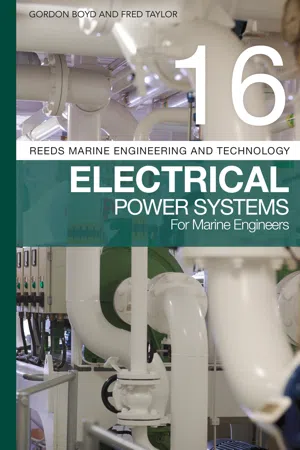![]()
1
INTRODUCTION AND OVERVIEW
Power systems for marine and offshore installations are by their nature smaller than those found onshore. They have always had the need to be complete systems with a requirement to not only distribute and utilise power, but also the need to generate it. This means that apart from carrying significant generating plant, those responsible for design, management and operation of these systems cannot assume that the source of electrical power is an ‘infinite’ busbar. Any changes in system configuration, demanded power or major faults are likely to have system-wide repercussions.
Developments over many decades have led to a steady rise in demand for electrical power together with a huge increase in the complexity, variety and sheer amount of electrical equipment and systems.
High levels of automation are now applied to sophisticated multi-fuel systems, some of which carry complex industrial plants while carrying thousands of passengers or, in the case of large offshore platforms, similar numbers of workers.
General developments associated with economic and environmental concerns mean that an increasing number of organisations onshore are now developing similar small, potentially ‘standalone’ systems.
An understanding of the background to these marine and offshore systems is considered worthwhile.
Types of Installation
The installations considered here range from generating capacities measured in tens of kW as found on many small craft through to generating capacities measured in hundreds of MW as needed on large passenger ships and production platforms. Although safety is of high priority in all cases, other priorities vary according to the application, with high production performance and reliability being vital in offshore installations while the comfort and pleasure of passengers is a priority for the cruise ship. There is also a general need to follow international rules and regulations, increasing pressure to be environmentally responsible as well as to meet the usual commercial demands. Some of these constraints are met by aspects of the electrical power system’s design and include variations on prime mover fuel type, different sizes of generator and type of propulsion system.
In principle, power starts with a prime mover and is converted to electrical power and then distributed to a wide range of consumers.
Figure 1.1 Generation – distribution – utilisation
In practice, it is far more complex and varied than suggested in Figure 1.1. Some generalised examples are shown in Figures 1.2–1.6. Be aware that there are many variants and alternatives to these arrangements.
Figure 1.2 440 V / 220 V system
Low voltage is generated and distributed as required.
Figure 1.3 690 V / 220 V system
In Figure 1.3 the system is still at low voltage, including the propulsion system, which is unlikely to be greater than about 5 MW. The demand for power is likely to be higher than for the previous example.
Some versions of this arrangement have completely separate main switchboards, thus giving major benefits in terms of redundancy.
Figure 1.4 simplifies what is in effect a very complex system.
The generating plant produces 6.6 kV, 60 Hz. The two largest generators will be rated at typically 12 MVA, with the two smaller units at a little over half that rating.
Each propulsion electric motor (PEM) needs to operate at high voltage (c. 2 kV) with power output in the region of 14 MW each. The synchro converter system is fully regenerative, providing braking as well as propulsion torque.
Other large consumers also operate at 6.6 kV, with each unit drawing power in the order of a few MW.
Switchable neutral earthing resistors (NERs) are employed at each main switchboard.
Figure 1.4 Liquefied natural gas carrier
Figure 1.5 also simplifies what is in effect a very complex system.
Large passenger ships are now required to have extensive redundancy so that the two switchboards will operate independently. The generating plant produces 11 kV, 60 Hz. The two largest generators will be rated at typically 20 MVA, with the two slightly smaller units at over half that rating.
Each PEM needs to operate at high voltage (c. 2 kV) with power output in the region of 20 MW each. The synchro converter system is fully regenerative, providing braking as well as propulsion torque.
Other large consumers also operate at 11 kV, with each unit drawing power in the order of a few MW.
Switchable NERs are employed at each main generator.
Yet again, Figure 1.6 simplifies what is in effect a very complex system.
The generating plant produces 13.8 kV, 60 Hz. The largest generators will be rated at typically 50 MVA, with low-voltage machines rated at 3 MVA. Apart from the extremely large propulsion plant, this kind of installation also requires large thrusters to support its positioning.
Other large consumers also operate at 6.6 kV, with each unit drawing power in the order of a few MW.
Switchable neutral earthing transformers (NETs) are employed at each high-voltage main busbar.
Figure 1.6 Production platform
Rules and Regulations
For the marine industry, Hull and Machinery construction rules and regulations are mainly set out by the Classification Societies, while operational safety requirements are defined by the Flag State bodies. The International Maritime Organization (IMO) and its conventions provide the basic guidance and framework for both. Therefore, the focus in regard to design, operation, survey and inspections relies on compliance with those rules and regulations.
These rules and regulations also apply to the offshore industry, although the requirements of national government bodies must also be followed.
SOLAS
Among many other safety-critical issues, Safety of Life at Sea (SOLAS) sets out requirements in regard to electrical installations. As an illustration, some salient points required for passenger ships are summarised here:
•The main sources of electrical power need to be sufficient to supply all necessary services.
•The main sources of electrical power shall at least consist of two generators.
•I...






